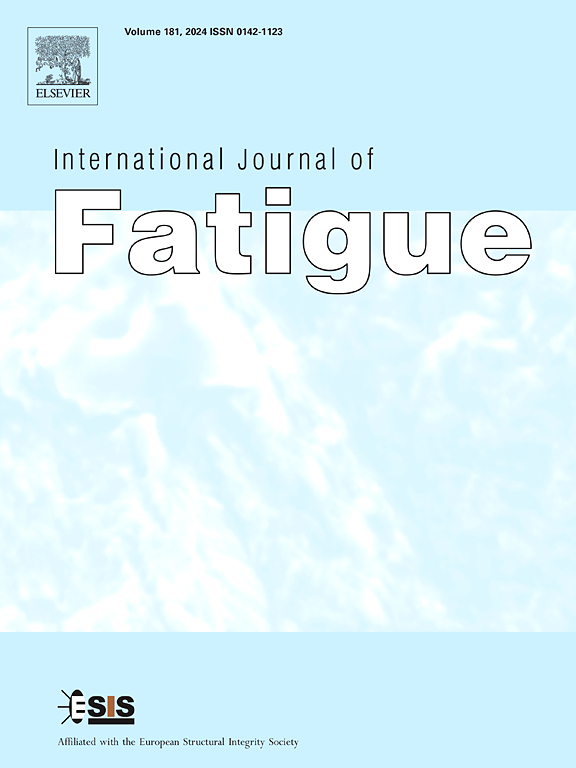Fatigue damage monitoring of hybrid step-lap joints in thick primary metallic aircraft structures using distributed optical fibre sensors
IF 6.8
2区 材料科学
Q1 ENGINEERING, MECHANICAL
引用次数: 0
Abstract
Hybrid joint configurations, which combine adhesive bonding with mechanical fastening, enhance joint strength in primary aircraft structures by leveraging the strengths of both methods. However, they also inherit the quality control challenges of adhesive bonding, particularly in ensuring bond integrity over time. Current non-destructive inspection techniques are limited in reliably detecting weak bonds in hybrid and bonded joints under real-world conditions. This study investigates the behaviour of hybrid and bonded joints with simulated bondline defects that may occur in practice. Distributed optical fibre sensors (DOFS) are employed to provide real-time strain monitoring while capturing disbond initiation and propagation across the overlap region. Findings show that fasteners in hybrid joints delayed crack initiation and slowed disbond growth by reducing Mode I opening and peeling stresses, leading to gradual strain increases and preserving residual strength. Thus, offering a window for maintenance before complete failure. In contrast, bonded joints with similar defects exhibited abrupt failure due to adhesive brittleness. Finite element analysis of the bonded configuration with a degraded adhesive was used to qualitatively validate experimental strain trends. Statistical analyses of the numerically simulated strains along the fibre and joint, including Root Mean Square Error (RMSE), Pearson correlation coefficient, and Maximum Absolute Error (MAE), were conducted to evaluate DOFS reliability. Results indicated a strong correlation between the two, though measurement precision slightly declined for larger disbonds. This study highlights how hybrid joints can enhance the structural durability of bonded step-lap repairs in thick metallic structures when concealed defects are present in the bondline, while establishing DOFS as a robust tool for real-time monitoring and proactive maintenance. This research is part of a certification assessment program for hybrid joining repairs in primary metallic aircraft structures.
基于分布式光纤传感器的飞机粗金属结构阶梯搭接混合接头疲劳损伤监测
结合胶粘接和机械紧固的混合连接结构,利用这两种方法的优势,提高了飞机主要结构的连接强度。然而,它们也继承了胶粘剂粘合的质量控制挑战,特别是在确保粘合完整性方面。目前的无损检测技术在实际条件下难以可靠地检测混合和粘结接头中的弱键。本文研究了混合和粘结接头的行为,并模拟了实际中可能出现的粘结线缺陷。采用分布式光纤传感器(DOFS)提供实时应变监测,同时捕获跨重叠区域的剥离开始和传播。研究结果表明,混合接头中的紧固件通过降低I型开口应力和剥离应力来延缓裂纹萌生和减缓脱粘生长,从而导致应变逐渐增加并保持残余强度。因此,在完全故障之前提供了一个维护窗口。相比之下,具有类似缺陷的粘结接头由于粘接剂脆性而发生突然破坏。采用有限元方法对退化胶粘剂的粘结结构进行了分析,定性地验证了试验应变趋势。对沿纤维和关节方向的数值模拟应变进行统计分析,包括均方根误差(RMSE)、Pearson相关系数和最大绝对误差(MAE),以评估DOFS的可靠性。结果表明两者之间存在很强的相关性,尽管测量精度在较大的剥离情况下略有下降。该研究强调了当结合线上存在隐藏缺陷时,混合接头如何提高厚金属结构的结合阶接修复的结构耐久性,同时将DOFS建立为实时监测和主动维护的强大工具。本研究是飞机初级金属结构混合连接维修认证评估项目的一部分。
本文章由计算机程序翻译,如有差异,请以英文原文为准。
求助全文
约1分钟内获得全文
求助全文
来源期刊

International Journal of Fatigue
工程技术-材料科学:综合
CiteScore
10.70
自引率
21.70%
发文量
619
审稿时长
58 days
期刊介绍:
Typical subjects discussed in International Journal of Fatigue address:
Novel fatigue testing and characterization methods (new kinds of fatigue tests, critical evaluation of existing methods, in situ measurement of fatigue degradation, non-contact field measurements)
Multiaxial fatigue and complex loading effects of materials and structures, exploring state-of-the-art concepts in degradation under cyclic loading
Fatigue in the very high cycle regime, including failure mode transitions from surface to subsurface, effects of surface treatment, processing, and loading conditions
Modeling (including degradation processes and related driving forces, multiscale/multi-resolution methods, computational hierarchical and concurrent methods for coupled component and material responses, novel methods for notch root analysis, fracture mechanics, damage mechanics, crack growth kinetics, life prediction and durability, and prediction of stochastic fatigue behavior reflecting microstructure and service conditions)
Models for early stages of fatigue crack formation and growth that explicitly consider microstructure and relevant materials science aspects
Understanding the influence or manufacturing and processing route on fatigue degradation, and embedding this understanding in more predictive schemes for mitigation and design against fatigue
Prognosis and damage state awareness (including sensors, monitoring, methodology, interactive control, accelerated methods, data interpretation)
Applications of technologies associated with fatigue and their implications for structural integrity and reliability. This includes issues related to design, operation and maintenance, i.e., life cycle engineering
Smart materials and structures that can sense and mitigate fatigue degradation
Fatigue of devices and structures at small scales, including effects of process route and surfaces/interfaces.
 求助内容:
求助内容: 应助结果提醒方式:
应助结果提醒方式:


